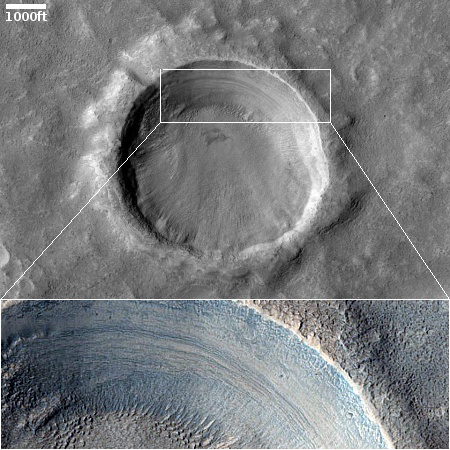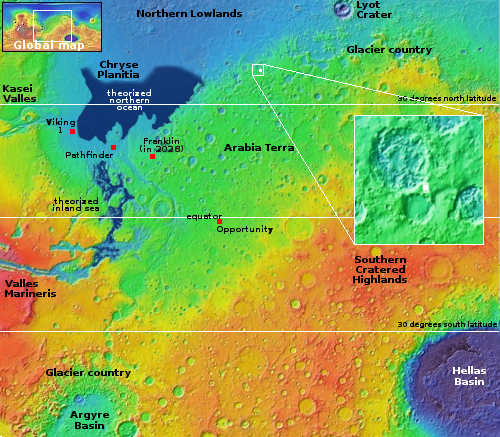Visible ice layers in a crater in the lower mid-latitudes of Mars?

Click for original image. For the original color image, go here.
Cool image time! The picture to the right, cropped, reduced, and sharpened to post here, was taken on July 14, 2023 by the high resolution camera on Mars Reconnaissance Orbiter (MRO), and shows what appear to be horizontal layers in the inner wall of a small one-mile-wide and 150-foot deep unnamed crater on Mars. I have included the color version below, zoomed in to make those layers and their colors very clear.
As I have not contacted the scientists who requested this picture, I can only guess at its purpose. My guess however relates to those horizontal blue layers, reminiscent of the ice layers seen in Martian scarps at the high latitudes at about 50 to 55 degrees.
Normally it is rare to see horizontal layers like this in craters on Mars. Instead, what you usually see are downward-pointing gullies along with drainage and avalanche-type patterns, though the latter two might not be formed by either drainage or avalanches.
In this case these horizontal layers are clear and pronounced, making this crater a possibly important and somewhat unique find, based on its location.

On the overview map to the right the white dot indicates the location of this crater, in Arabia Terra, the largest transition region between the northern lowland plains and the southern cratered highlands. The latitude is 38 degrees north, which if those blue layers are ice would make them the closest to the equator yet found.
The location in these mid-latitudes is also relatively near the 2,000-mile-long region I dub glacier country, which begins only a few hundred miles to the east. Even though this is not in that glacial region, at this latitude there is ample evidence here of near surface ice, though that evidence is usually revealed by glacial features inside craters, not by distinct underground ice layers on crater walls.
One of the unanswered questions about the ice on Mars is how close to the equator and how deep underground does ice exist? Does it vanish entirely in the tropics, or do the ice layers end up deeper underground? This picture doesn’t answer the question, except that it suggests there are ice layers at 38 degrees north latitude, far closer to the equator than the evidence previously suggested.
One very important caveat: I am merely guessing that the blue layers are ice, and my guess could be entirely wrong. Keep that in mind as you make your own speculations.
On Christmas Eve 1968 three Americans became the first humans to visit another world. What they did to celebrate was unexpected and profound, and will be remembered throughout all human history. Genesis: the Story of Apollo 8, Robert Zimmerman's classic history of humanity's first journey to another world, tells that story, and it is now available as both an ebook and an audiobook, both with a foreword by Valerie Anders and a new introduction by Robert Zimmerman.
The ebook is available everywhere for $5.99 (before discount) at amazon, or direct from my ebook publisher, ebookit. If you buy it from ebookit you don't support the big tech companies and the author gets a bigger cut much sooner.
The audiobook is also available at all these vendors, and is also free with a 30-day trial membership to Audible.
"Not simply about one mission, [Genesis] is also the history of America's quest for the moon... Zimmerman has done a masterful job of tying disparate events together into a solid account of one of America's greatest human triumphs."--San Antonio Express-News

Click for original image. For the original color image, go here.
Cool image time! The picture to the right, cropped, reduced, and sharpened to post here, was taken on July 14, 2023 by the high resolution camera on Mars Reconnaissance Orbiter (MRO), and shows what appear to be horizontal layers in the inner wall of a small one-mile-wide and 150-foot deep unnamed crater on Mars. I have included the color version below, zoomed in to make those layers and their colors very clear.
As I have not contacted the scientists who requested this picture, I can only guess at its purpose. My guess however relates to those horizontal blue layers, reminiscent of the ice layers seen in Martian scarps at the high latitudes at about 50 to 55 degrees.
Normally it is rare to see horizontal layers like this in craters on Mars. Instead, what you usually see are downward-pointing gullies along with drainage and avalanche-type patterns, though the latter two might not be formed by either drainage or avalanches.
In this case these horizontal layers are clear and pronounced, making this crater a possibly important and somewhat unique find, based on its location.

On the overview map to the right the white dot indicates the location of this crater, in Arabia Terra, the largest transition region between the northern lowland plains and the southern cratered highlands. The latitude is 38 degrees north, which if those blue layers are ice would make them the closest to the equator yet found.
The location in these mid-latitudes is also relatively near the 2,000-mile-long region I dub glacier country, which begins only a few hundred miles to the east. Even though this is not in that glacial region, at this latitude there is ample evidence here of near surface ice, though that evidence is usually revealed by glacial features inside craters, not by distinct underground ice layers on crater walls.
One of the unanswered questions about the ice on Mars is how close to the equator and how deep underground does ice exist? Does it vanish entirely in the tropics, or do the ice layers end up deeper underground? This picture doesn’t answer the question, except that it suggests there are ice layers at 38 degrees north latitude, far closer to the equator than the evidence previously suggested.
One very important caveat: I am merely guessing that the blue layers are ice, and my guess could be entirely wrong. Keep that in mind as you make your own speculations.
On Christmas Eve 1968 three Americans became the first humans to visit another world. What they did to celebrate was unexpected and profound, and will be remembered throughout all human history. Genesis: the Story of Apollo 8, Robert Zimmerman's classic history of humanity's first journey to another world, tells that story, and it is now available as both an ebook and an audiobook, both with a foreword by Valerie Anders and a new introduction by Robert Zimmerman.
The ebook is available everywhere for $5.99 (before discount) at amazon, or direct from my ebook publisher, ebookit. If you buy it from ebookit you don't support the big tech companies and the author gets a bigger cut much sooner.
The audiobook is also available at all these vendors, and is also free with a 30-day trial membership to Audible.
"Not simply about one mission, [Genesis] is also the history of America's quest for the moon... Zimmerman has done a masterful job of tying disparate events together into a solid account of one of America's greatest human triumphs."--San Antonio Express-News


Readers: the rules for commenting!
No registration is required. I welcome all opinions, even those that strongly criticize my commentary.
However, name-calling and obscenities will not be tolerated. First time offenders who are new to the site will be warned. Second time offenders or first time offenders who have been here awhile will be suspended for a week. After that, I will ban you. Period.
Note also that first time commenters as well as any comment with more than one link will be placed in moderation for my approval. Be patient, I will get to it.